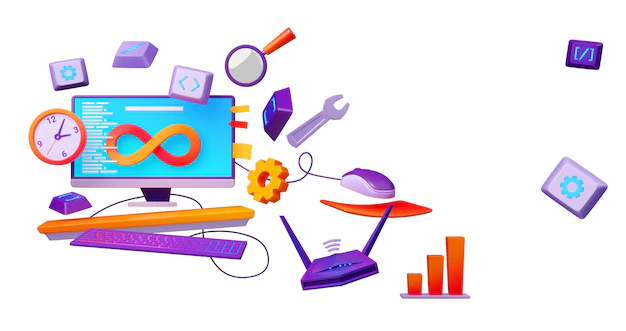DevOps Architects: Defining Roles And Responsibilities In Modern Tech

Technology is a fast-paced and ever-evolving landscape, and DevOps architect roles and responsibilities have become increasingly crucial to the industry. DevOps architects bridge the development and operations teams, ensuring that development processes are seamlessly integrated when both teams embark on the software development lifecycle.
In this article, we will delve into the core responsibilities, evolving trends, key skills, and other nuances that define the roles and responsibilities of DevOps architects in modern tech environments. We will also explore what it means to be a DevOps architect and the crucial nature that surrounds the software development skill.
Overview of the Roles of DevOps Architects
DevOps architecture is a holistic approach that seeks to unify software development (Dev) and IT operations (Ops). The goal of a DevOps architect is to shorten the system development life cycle and continuously deliver high-quality software. DevOps architects are critical in designing and implementing these practices by ensuring seamless collaboration and communication between operations and development.
Core Responsibilities of DevOps Architects
The DevOps architect job description carries a multifaceted set of responsibilities, from strategic planning to hands-on implementation and collaboration. At the center of their responsibility is the need to streamline and optimize the software development process.
By streamlining, DevOps architects ensure a quick, neat, and seamless development process, with hassle-free continuance, even if software development teams are changed mid-project. This involves defining and managing the deployment pipelines, implementing automation for continuous integration and continuous delivery (CI/CD), and orchestrating crucial workflows,
DevOps architect responsibility is also to foster a culture of collaboration and communication, breaking down technical and traditional barriers between two core teams – development and operations. A successful DevOps-integrated software development process achieves a more efficient and agile development process.
Key Skills and Competencies of DevOps Architects

To effectively navigate the complex landscape of modern technology, DevOps architect responsibilities include technical proficiency and deep understanding of infrastructure as code, cloud computing, and containerization. They should be adept at utilizing various tools and technologies, like Kubernetes, Docker, Jenkins, and Ansible, to automate and streamline workflows seamlessly.
While technical skills are necessary, DevOps architects must also excel in soft skills, including effective communication, collaboration, and problem-solving. They must be able to adapt to a continually changing software environment, learn the essentials of software infrastructure and collaboration, and survive in an environment where technology is in a constant state of evolution.
Collaboration with Development Teams
Business DevOps architects play a crucial role in fostering collaboration within development teams, striving to seamlessly integrate DevOps practices into the intricate world of the software development process. Their work involves close partnerships with developers, delving deep into the intricacies of application requirements. This collaborative journey goes beyond merely focusing on technical aspects; it’s about cultivating a shared culture of responsibility and ownership.
In this relationship, DevOps architects don’t just guide on optimizing code for deployment; they actively champion a sense of shared responsibility. This means going beyond the lines of code and encouraging developers to take ownership of their creations throughout the entire lifecycle — from the initial stages of development through the deployment phase and beyond. This approach transforms the development landscape into a dynamic ecosystem of shared goals and mutual accountability.
The collaborative ethos embraced by DevOps architects becomes a catalyst for a culture where every team member feels a sense of ownership in the project’s success. It’s not just about writing code; it’s about cultivating a mindset where everyone is invested in the journey, understanding the nuances of each line of code, and appreciating how it contributes to the broader objectives of the project.
This shared responsibility culture is particularly pivotal in achieving the agility and speed demanded by modern tech environments. DevOps isn’t just a set of practices; it’s a mindset, a culture that encourages continuous collaboration, learning, and improvement. DevOps architects empower developers to transcend the traditional boundaries between development and deployment by fostering this culture.
Imagine a scenario where developers write code and actively engage in the deployment process, understanding how their contributions shape the end product. DevOps architects facilitate this by instilling a mindset where developers are more than code creators; they are stakeholders in the entire lifecycle. This enhances the efficiency of CI/CD pipelines and contributes to a more robust and resilient software development process.
Partnership with Operations Teams
Beyond their collaboration with development teams, DevOps architects embark on a strategic partnership with operations teams, creating a harmonious synergy that optimizes operational workflows and elevates application deployment and maintenance efficiency and reliability.
This collaboration isn’t just about sharing a workspace; it’s about co-creating a seamless environment where development and operations converge for a common purpose—to develop quality software. In the world of DevOps architecture, stories abound of how this collaboration transforms the traditionally siloed landscapes of development and operations into a cohesive unit, each contributing to the other’s success.
Consider a dynamic tech company where DevOps architects and operations teams collaborate to streamline their operational workflows. They identified pain points in the deployment process through meticulous collaboration, addressing bottlenecks, and refining procedures. The result? An efficient operational system where applications were deployed with precision, reducing downtime and enhancing overall system reliability.
This partnership is not just about problem-solving; it’s about envisioning a future where operations seamlessly align with development goals. Often, with DevOps architects pushing for technical and traditional collaboration, cumbersome manual deployment processes can be converted into automated and more efficient processes. This not only reduces the burden on operations teams but also allows them to reallocate time to more strategic initiatives.
The crucial factor in this partnership is Infrastructure as Code (IaC) practices, an innovative process in DevOps. Picture this: a DevOps architect introducing IaC to an operations team, unlocking the potential for infrastructure provisioning and configuration automation. In this narrative, the manual process of configuring servers and managing infrastructure becomes obsolete.
Security Integration
DevOps architects are responsible for integrating security measures seamlessly into the software development process. This involves implementing security best practices, conducting regular security assessments, and ensuring compliance with industry standards and regulations. For DevOps, security is crucial, not an afterthought.
Conclusion
DevOps architects play a pivotal role in the dynamic tech landscape, bridging development and operations. Their multifaceted responsibilities, from streamlining processes to fostering collaboration, define a human-centric approach. Collaborating seamlessly with operations teams, they transform workflows and champion security integration as a core element. As pioneers adapting to trends, DevOps architects guide teams toward shared success in the ever-evolving world of modern tech.
Read Also:













